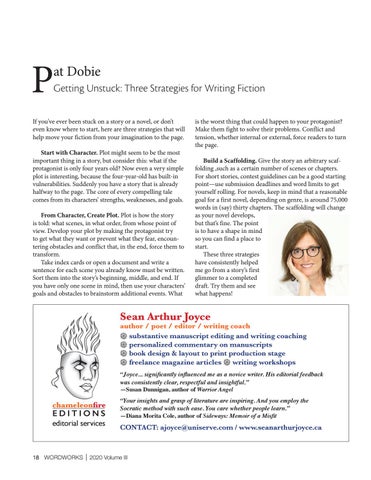P
at Dobie Getting Unstuck: Three Strategies for Writing Fiction
If you’ve ever been stuck on a story or a novel, or don’t even know where to start, here are three strategies that will help move your fiction from your imagination to the page. Start with Character. Plot might seem to be the most important thing in a story, but consider this: what if the protagonist is only four years old? Now even a very simple plot is interesting, because the four-year-old has built-in vulnerabilities. Suddenly you have a story that is already halfway to the page. The core of every compelling tale comes from its characters’ strengths, weaknesses, and goals. From Character, Create Plot. Plot is how the story is told: what scenes, in what order, from whose point of view. Develop your plot by making the protagonist try to get what they want or prevent what they fear, encountering obstacles and conflict that, in the end, force them to transform. Take index cards or open a document and write a sentence for each scene you already know must be written. Sort them into the story’s beginning, middle, and end. If you have only one scene in mind, then use your characters’ goals and obstacles to brainstorm additional events. What
is the worst thing that could happen to your protagonist? Make them fight to solve their problems. Conflict and tension, whether internal or external, force readers to turn the page. Build a Scaffolding. Give the story an arbitrary scaffolding ,such as a certain number of scenes or chapters. For short stories, contest guidelines can be a good starting point—use submission deadlines and word limits to get yourself rolling. For novels, keep in mind that a reasonable goal for a first novel, depending on genre, is around 75,000 words in (say) thirty chapters. The scaffolding will change as your novel develops, but that’s fine. The point is to have a shape in mind so you can find a place to start. These three strategies have consistently helped me go from a story’s first glimmer to a completed draft. Try them and see what happens!
Sean Arthur Joyce
author / poet / editor / writing coach 4 substantive manuscript editing and writing coaching 4 personalized commentary on manuscripts 4 book design & layout to print production stage 4 freelance magazine articles 4 writing workshops “Joyce... significantly influenced me as a novice writer. His editorial feedback was consistently clear, respectful and insightful.” —Susan Dunnigan, author of Warrior Angel
chameleonfire
EDITIONS editorial services
“Your insights and grasp of literature are inspiring. And you employ the Socratic method with such ease. You care whether people learn.” —Diana Morita Cole, author of Sideways: Memoir of a Misfit
CONTACT: ajoyce@uniserve.com / www.seanarthurjoyce.ca
18 WORDWORKS ︱ 2020 Volume III














